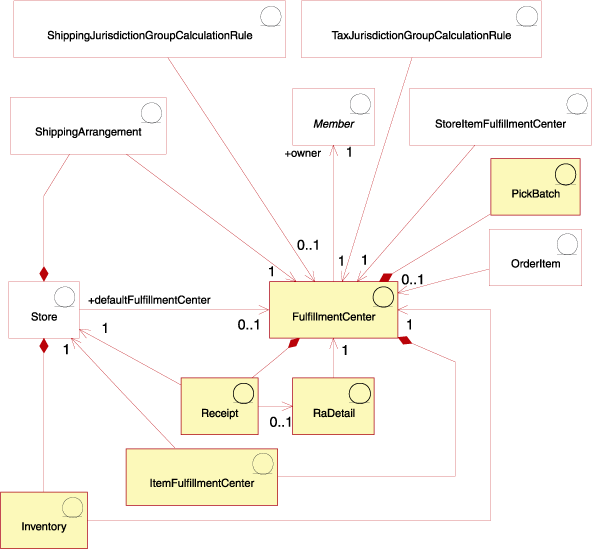Fulfillment assets
A Fulfillment package. In WebSphere Commerce, fulfillment is the process of filling an order for a client. A fulfillment center serves as a storage warehouse where products are packaged and shipped to customers. Fulfillment centers, stores, and shipping carriers are treated as separate entities. Fulfillment is not particular to any store. Each store can use Fulfillment and the store object is shown as dependent on the Fulfillment package. Fulfillment centers are used by stores as both inventory warehouses and shipping and receiving centers. A fulfillment center represents a place from which products are shipped to customers. Inventory counts are maintained separately for each fulfillment center. One store can have one or many fulfillment centers associated with it. The fulfillment center manages the product inventory and shipping for a store. Fulfillment includes picking, packing, and shipping. Picking is the selection of products in one or more releases from a fulfillment center, packing is putting these products into shipping containers, and shipping is sending the products to customers.Products are configured for fulfillment with the Product wizard and the Product notebook. Product configuration provides options to track inventory, allow a backorder, force a backorder, release the product separately, and specify that the product is not to be returned.
Typically, there are a number of people that are working in a fulfillment center at one time, each with a different task or tasks to perform.
To understand fulfillment assets, it is necessary to understand the relationships between
fulfillment and the store. This relationship can be explained by the use of an information model.
The following sections describe the relationship between fulfillment assets, a store, and other
assets.

- Fulfillment center
- Receipts
- RaDetail
- Inventory
- Shipping arrangements
- Other fulfillment assets
- In the preceding diagram, the fulfillment center is at the center of the fulfillment process. A fulfillment center has an owner, which is defined in the MEMBER table. Each store can be associated with multiple fulfillment centers, and a
fulfillment center can have several stores associated with it. There are several
interactions between the store and the fulfillment center, as indicated in the diagram.
- Fulfillment centers receive inventory for items on a daily, weekly, or monthly basis. When
inventory is received for an item, a receipt is created in the RECEIPT table which records information about the quantity that is received, and the store which owns the inventory. As orders are processed, the RECEIPT table is
updated to reflect the current available inventory levels.
- RaDetail is the detailed information about items on an expected inventory record.
This information can be used to estimate when inventory can be expected to be received at a
fulfillment center. This information can also be used to provide customers with expected shipping
dates for items that are on backorder.
- A store has inventory which is associated with the fulfillment center.
Inventory includes everything that can be physically accounted for in a fulfillment center.
Inventory is associated with one store and one fulfillment center. Information about the inventory
that a store owns at the fulfillment center is also recorded. For example, information about the inventory such as reserved quantities, amounts on backorder, and amounts that are allocated to a
backorder is also recorded. This information is stored in the ITEMFFMCTR
table.
- A shipping arrangement is a relationship that enables a store to use a
fulfillment center. Shipping arrangements indicate that a fulfillment center can ship products on
behalf of a store by using a shipping mode. Each store has a shipping arrangement with a fulfillment
center. Shipping arrangements are set up in the SHPARRANGE table.
- There are other relationships to a fulfillment center that are not directly related to a store.
A pick batch is one associated with one fulfillment center. A pick batch groups order
releases for their processing as a unit at a fulfillment center, and creates pick slips and pack
slips. Once items are picked and packed, an order release can then be shipped, and the shipment can be confirmed. Pick batch information is stored in the PICKBATCH table. An order
item is also associated with one fulfillment center. An item is a specific instance of a product,
which is defined by attributes. Information about each item in an order is stored in the ORDERITEMS table.
Like other entities, a fulfillment center has rules which govern some of its actions. Each fulfillment center has rules for tax and shipping charges. These rules are defined in the TAXJCRULE and SHPJCRULE tables.
Related concepts
Store data information model